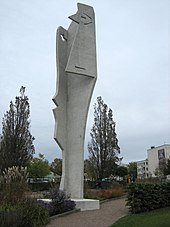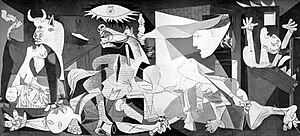| “ | Art is a lie that makes us realize the truth. | ” |
| — Pablo Picasso [32] |
In 1939–40 the Museum of Modern Art in New York City, under its director Alfred Barr, a Picasso enthusiast, held a major and highly successful retrospective of his principal works up until that time. This exhibition lionized the artist, brought into full public view in America the scope of his artistry, and resulted in a reinterpretation of his work by contemporary art historians and scholars.[33]
Before 1901
Picasso’s training under his father began before 1890. His progress can be traced in the collection of early works now held by the Museu Picasso in Barcelona, which provides one of the most comprehensive records extant of any major artist’s beginnings.[34] During 1893 the juvenile quality of his earliest work falls away, and by 1894 his career as a painter can be said to have begun.[35] The academic realism apparent in the works of the mid-1890s is well displayed in The First Communion (1896), a large composition that depicts his sister, Lola. In the same year, at the age of 14, he painted Portrait of Aunt Pepa, a vigorous and dramatic portrait that Juan-Eduardo Cirlot has called “without a doubt one of the greatest in the whole history of Spanish painting.”[36]In 1897 his realism became tinged with Symbolist influence, in a series of landscape paintings rendered in non naturalistic violet and green tones. What some call his Modernist period (1899–1900) followed. His exposure to the work of Rossetti, Steinlen, Toulouse-Lautrec and Edvard Munch, combined with his admiration for favorite old masters such as El Greco, led Picasso to a personal version of modernism in his works of this period.[37]
Blue Period
La Vie (1903), Cleveland Museum of Art
Femme aux Bras Croisés, 1902
For more details on this topic, see Picasso's Blue Period.
Picasso’s Blue Period (1901–1904) consists of somber paintings rendered in shades of blue and blue-green, only occasionally warmed by other colors. This period’s starting point is uncertain; it may have begun in Spain in the spring of 1901, or in Paris in the second half of the year.[38] Many paintings of gaunt mothers with children date from this period. In his austere use of color and sometimes doleful subject matter—prostitutes and beggars are frequent subjects—Picasso was influenced by a trip through Spain and by the suicide of his friend Carlos Casagemas. Starting in autumn of 1901 he painted several posthumous portraits of Casagemas, culminating in the gloomy allegorical painting La Vie (1903),[39] now in the Cleveland Museum of Art.[40]The same mood pervades the well-known etching The Frugal Repast (1904),[41] which depicts a blind man and a sighted woman, both emaciated, seated at a nearly bare table. Blindness is a recurrent theme in Picasso’s works of this period, also represented in The Blindman’s Meal (1903, the Metropolitan Museum of Art) and in the portrait of Celestina (1903). Other works include Portrait of Soler and Portrait of Suzanne Bloch.
Rose Period
For more details on this topic, see Picasso's Rose Period.
The Rose Period (1904–1906)[42] is characterized by a more cheery style with orange and pink colors, and featuring many circus people, acrobats and harlequins known in France as saltimbanques. The harlequin, a comedic character usually depicted in checkered patterned clothing, became a personal symbol for Picasso. Picasso met Fernande Olivier, a model for sculptors and artists, in Paris in 1904, and many of these paintings are influenced by his warm relationship with her, in addition to his increased exposure to French painting. The generally upbeat and optimistic mood of paintings in this period is reminiscent of the 1899–1901 period (i.e. just prior to the Blue Period) and 1904 can be considered a transition year between the two periods.African-influenced Period
For more details on this topic, see Picasso's African Period.
Picasso’s African-influenced Period (1907–1909) begins with the two figures on the right in his painting, Les Demoiselles d'Avignon, which were inspired by African artifacts. Formal ideas developed during this period lead directly into the Cubist period that follows.Cubism
Analytic cubism (1909–1912) is a style of painting Picasso developed along with Georges Braque using monochrome brownish and neutral colors. Both artists took apart objects and “analyzed” them in terms of their shapes. Picasso and Braque’s paintings at this time have many similarities. Synthetic cubism (1912–1919) was a further development of the genre, in which cut paper fragments—often wallpaper or portions of newspaper pages—were pasted into compositions, marking the first use of collage in fine art.Classicism and surrealism
In the period following the upheaval of World War I, Picasso produced work in a neoclassical style. This “return to order” is evident in the work of many European artists in the 1920s, including André Derain, Giorgio de Chirico, and the artists of the New Objectivity movement. Picasso’s paintings and drawings from this period frequently recall the work of Ingres.During the 1930s, the minotaur replaced the harlequin as a common motif in his work. His use of the minotaur came partly from his contact with the surrealists, who often used it as their symbol, and it appears in Picasso’s Guernica.
Arguably Picasso’s most famous work is his depiction of the German bombing of Guernica during the Spanish Civil War—Guernica. This large canvas embodies for many the inhumanity, brutality and hopelessness of war. Asked to explain its symbolism, Picasso said, “It isn’t up to the painter to define the symbols. Otherwise it would be better if he wrote them out in so many words! The public who look at the picture must interpret the symbols as they understand them.”[43][44]
Guernica hung in New York’s Museum of Modern Art for many years. In 1981 Guernica was returned to Spain and exhibited at the Casón del Buen Retiro. In 1992 the painting hung in Madrid’s Reina Sofía Museum when it opened.
Later works
Picasso was one of 250 sculptors who exhibited in the 3rd Sculpture International held at the Philadelphia Museum of Art in mid-1949. In the 1950s, Picasso’s style changed once again, as he took to producing reinterpretations of the art of the great masters. He made a series of works based on Velazquez’s painting of Las Meninas. He also based paintings on works by Goya, Poussin, Manet, Courbet and Delacroix.
Nude Woman with a Necklace (1968), Tate
Picasso’s final works were a mixture of styles, his means of expression in constant flux until the end of his life. Devoting his full energies to his work, Picasso became more daring, his works more colorful and expressive, and from 1968 through 1971 he produced a torrent of paintings and hundreds of copperplate etchings. At the time these works were dismissed by most as pornographic fantasies of an impotent old man or the slapdash works of an artist who was past his prime. Only later, after Picasso’s death, when the rest of the art world had moved on from abstract expressionism, did the critical community come to see that Picasso had already discovered neo-expressionism and was, as so often before, ahead of his time.
Commemoration and legacy

Picasso sculpture in Halmstad
The Museu Picasso in Barcelona features many of Picasso’s early works, created while he was living in Spain, including many rarely seen works which reveal Picasso’s firm grounding in classical techniques. The museum also holds many precise and detailed figure studies done in his youth under his father’s tutelage, as well as the extensive collection of Jaime Sabartés, Picasso’s close friend and personal secretary.
Several paintings by Picasso rank among the most expensive paintings in the world. Garçon à la pipe sold for US$104 million at Sotheby's on 4 May 2004, establishing a new price record. Dora Maar au Chat sold for US$95.2 million at Sotheby’s on 3 May 2006.[46] On 4 May 2010, Nude, Green Leaves and Bust was sold at Christie's for $106.5 million. The 1932 work, which depicts Picasso's mistress Marie-Thérèse Walter reclining and as a bust, was in the personal collection of Los Angeles philanthropist Frances Lasker Brody, who died in November 2009. Christie's won the rights to auction the collection against London-based Sotheby's. The collection as a whole was valued at over $150 million, while the work was originally expected to earn $80 million at auction.[47] There were more than half a dozen bidders, while the winning bid was taken via telephone.[48][49] The previous auction record ($104.3 million) was set in February 2010, by Alberto Giacometti's Walking Man I.[50]
As of 2004, Picasso remains the top ranked artist (based on sales of his works at auctions) according to the Art Market Trends report.[51] More of his paintings have been stolen than those by any other artist;[52] the Art Loss Register has 550 of his works listed as missing.[53]
The Picasso Administration functions as his official Estate. The U.S. copyright representative for the Picasso Administration is the Artists Rights Society.[54]
In the 1996 movie Surviving Picasso, Picasso is portrayed by actor Anthony Hopkins.
Between October 8, 2010 and January 17, 2011, an exhibition of 150 paintings, sculptures, drawings, prints and photographs from the Museé National Picasso in Paris will be on display at the Seattle Art Museum. From Feb 19, 2011 to May 15, 2011, the exhibition from the Museé National Picasso will move to Richmond, VA and be on display at the Virginia Museum of Fine Arts for its only appearance on the east coast of the United States.[55]









0 comments:
Post a Comment